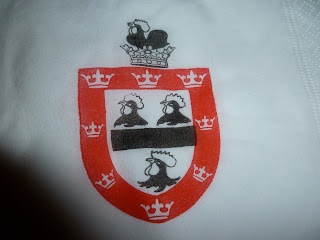Again, I'm getting pretty bad with the updates. Sorry! Things have been quite busy here, what with it being half term, but hopefully I'll be better in the future!
The first half of the term wasn't super heavy with the formals, but things seem to have picked up because I've had two in the last two weeks, and one on the horizon. I love formal halls, especially when I get to go to other colleges. Formal at Churchill is not quite as exciting any more, particularly because it is one of the more relaxed halls, but it's still a thrill to get to eat in halls that are hundreds of years old!
At the same time, that's life here! Often, it's freakishly easy to forget the fact that most of the world does not dine in medieval halls and then spent the evening drinking port on a regular basis. But, when you think about it, with 31 colleges, if each only had one formal a week, then there would still be tons going on, and some colleges have them every day! I guess that's my rationalization for the fact that the lifestyle here is kind of ridiculously great.
Anyways, the other night I got to go to formal at one of the colleges that you think of when you think of Cambridge: Trinity. For those who don't know, my dad was actually a student at Trinity back in the 70s after he left Amherst (yes, we are basically the same person), so I was even more excited to get to see the hall.
But, as always, first some fun facts about Trinity:
As I said, it's one of the biggies: the largest of the Oxbridge colleges and the leader in Nobel prizes at Cambridge (guess who's second? It's Churchill!) It was founded by Henry VIII (the one on "The Tudors" who killed all his wives) in 1546 only five weeks before he died. It was actually formed as a conglomeration of two already existing colleges and was given a pretty sizable endowment (which it still enjoys today).
In honor of it's founder, there is a statue of Henry at the Great Gate to the college. You'd think he'd be holding a scepter, but in his right hand he actually holds a chair leg (a 19th century student's joke)! Nearby the Gate, there is a "statue" of a different sort: a descendent of the apple tree that was said to have inspired Isaac Newton (a Trinity man) to explore the laws of gravity. Other famous Trinity men (whose statues adorn the chapel) were Alfred, Lord Tennyson and Francis Bacon.
The Great Court wasn't designed until the reign of Elizabeth I, but it is the largest court in Oxford or Cambridge. Two key hallmarks of the Court are the central fountain and the clock tower. The clock strikes the hours twice, once with a low tone, once with a high one (the clock 'with a male and female voice' of Wordsworth's Prelude). There is a tradition whereby undergrads try and run around the Great Court as the clock is striking twelve (a challenge featured in the movie "Chariots of Fire"). There are a lot of other odd traditions at Trinity (as at many of the older colleges), like the fact that the undergrads where blue, not black robes, and the porters wear bowler hats.
The hall, where we had formal, is absolutely gorgeous. It's Elizabethan, and meant to model London's Middle Temple. The walls are hung with portraits of Trinity men (Byron, Dryden, and Lord Rutherford) and a painting of Henry VIII hangs at the head of the hall.
(The last famous Trinity building, which I have yet to go to, is the Wren Library. More on that later once I've made it there).
Phew! As you can probably tell, Trinity is a college with a great history. However, being one of the largest colleges, it still has a pretty large sway on contemporary Cambridge life. A lot of my friends, both on the Gate and not, are at Trinity, and a couple of my friends from lab invited me to the annual Valentines Day Hall (although I'm not sure what was so Valentines-y about it, as it was almost a week later and there weren't any decorations up, but whatever). The food was quite good, and we were given wine, which probably made it one of the most valuable (bang for your buck) formals that I've been to here. But probably the most exciting thing is eating in a hall lit by candlelight!
This was the first time that I went to someone else's hall as a guest but not on a Gates swap, and it was a fun experience to not just hang out with people I already new but to get to meet "friends of friends." The people I know in lab have been at Cambridge for a long time (some were even here as undergrads) and it is neat to see how at home they are here (for most of my friends everything is new but for them it's old hat!). It definitely made me wish I was staying longer, but for now I guess I'm just trying to get everything out of it that I can!
Some pictures from my night at Trinity!
 |
| We cut the desserts into heart shapes in honor of Valentine's Day! |
 |
| Continuing my fascination with marked china, all the Trinity plates had the seal printed on them! |















